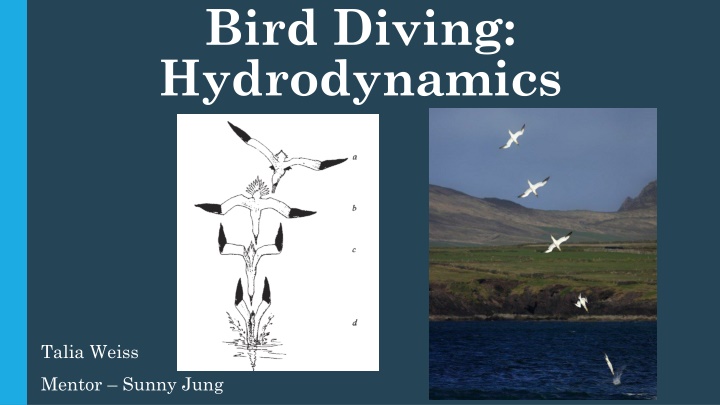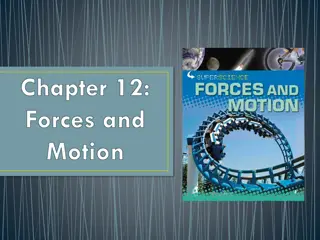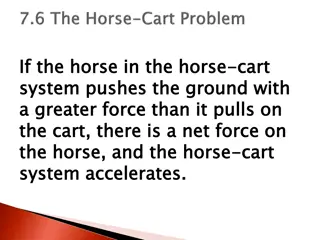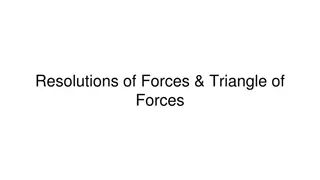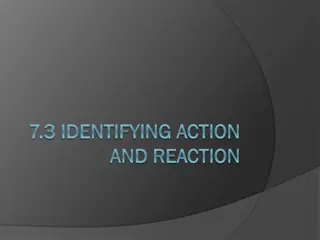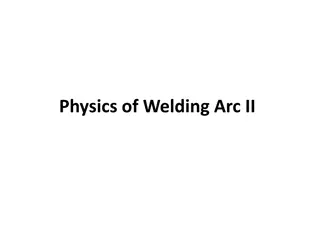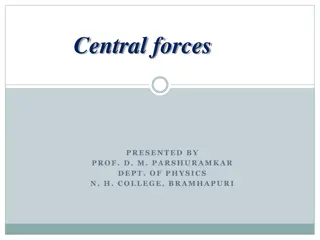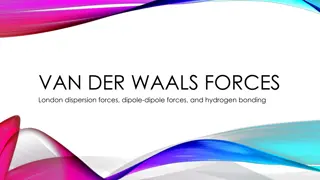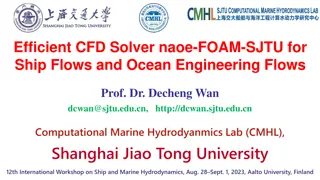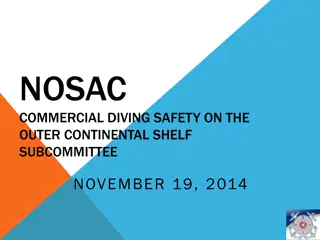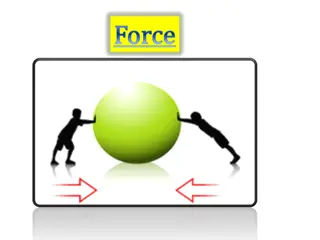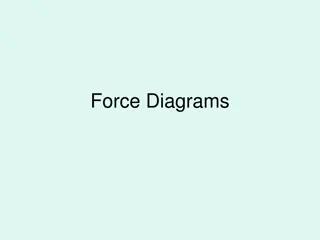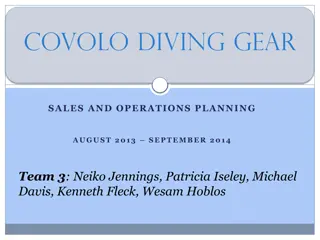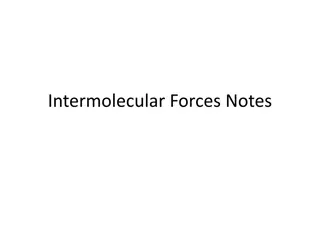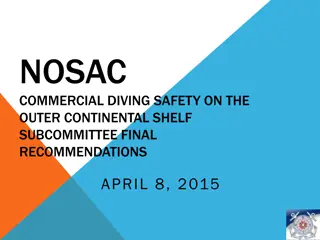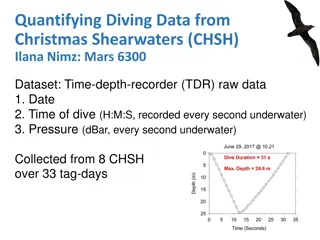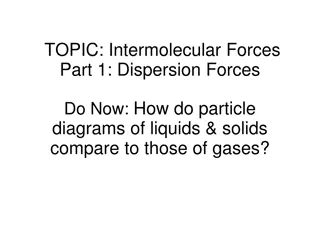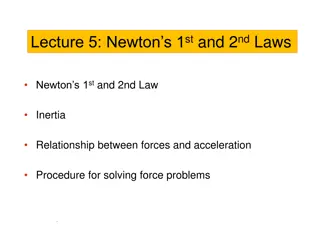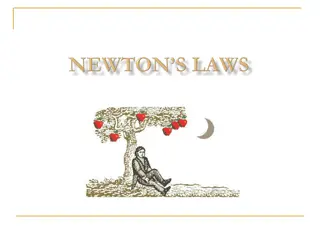Investigating the Forces and Deceleration in Bird Diving Hydrodynamics
Research explores the impact acceleration and forces involved when birds dive into water, focusing on gannets. Conflicting data regarding deceleration post-impact highlights the need for further study to match experimental findings with theoretical models and gain insight with simpler models.
Download Presentation

Please find below an Image/Link to download the presentation.
The content on the website is provided AS IS for your information and personal use only. It may not be sold, licensed, or shared on other websites without obtaining consent from the author.If you encounter any issues during the download, it is possible that the publisher has removed the file from their server.
You are allowed to download the files provided on this website for personal or commercial use, subject to the condition that they are used lawfully. All files are the property of their respective owners.
The content on the website is provided AS IS for your information and personal use only. It may not be sold, licensed, or shared on other websites without obtaining consent from the author.
E N D
Presentation Transcript
Bird Diving: Hydrodynamics Talia Weiss Mentor Sunny Jung
Wang, T. M., et al. "CFD based investigation on the impact acceleration when a gannet impacts with water during plunge diving." Bioinspiration & biomimetics 8.3 (2013): 036006.
25 m/s 3 m/s Can the forces involved in diving be enough to cause the neck injury? What ARE the forces anyway?
Currently Conflicting Information accelerometer Ropert Coudert, Yan, et al. "Between air and water: the plunge dive of the Cape Gannet Morus capensis." Ibis 146.2 (2004): 281-290.
absence of rapid deceleration recorded when birds hit the water surface . However, diving speed of Gannet hitting the water up to speeds of 24 m/s , however, recorded underwater speed in paper is ~3 m/s, and underwater descent only 1.36 sec. So some deceleration had to happen when bird hits surface
CFD Model Wang, T. M., et al. "CFD based investigation on the impact acceleration when a gannet impacts with water during plunge diving." Bioinspiration & biomimetics 8.3 (2013): 036006.
Model shows large deceleration within finished within 0.1 seconds of impact. This could easily be missed/ignored as noise for the sampling frequency of 32 Hz (1 sample every .03 seconds, so 3 samples taken within the yellow region on left)
Another inconsistency is whether the bird is decelerating during the dive after the initial impact .experiments are noisy but claim no, models show small constant deceleration after the first 0.1 seconds.
Objectives Try and gain intuition with simpler models in order to match experimental data with theory Truscott, Tadd T., Brenden P. Epps, and Alexandra H. Techet. "Unsteady forces on spheres during free- surface water entry." Journal of Fluid Mechanics 704 (2012): 173-210.
Potential flow models/method of images We can describe an irrotational, incompressible fluid velocity field, ?, as the gradient of a potential flow ?: ? = ? ? We can then use a sum of different potential functions that are nice (such as sources and sinks to describe a physical situation). Once we have the velocity field for a situation, we can take advantage of Navier-Stokes and other fluid equations to analytically solve for forces.
Combine with conformal mapping Using conformal mapping, one can map a simple, shape to a complex shape using a mapping function (that can be analytically or numerically derived). This map can then be used on the simple velocity field to get the velocity field for the more complex geometry ?
Conformal mapping Conformal mapping is very limited in 3D due to Liouville s theorem Essentially only Mobius transformations (translations, similarities, inversions, and orthogonal transformation) allowed in 3D ? So let s examine the 2D problem to see if we can get anywhere:
So how to we get the velocity field around a wedge? Conformal map the real line MAP! ?1 ?2 ?1 ?2 ?3 ?4 ?5 ?4 ?5 ?3 Z-plane ? ?????
Why this shape is important Air-water interface beak Time 1 Time 2 Time 3
Schwartz-Christoffel Transform There is a closed form, analytical solution from mapping the real line to any polygon including those with infinite vertices Bergonio, Philip Palma. Schwarz-Christoffel transformations. Diss. uga, 2007.
2a ??1 ??2 ??4 ??5 ?1 ?2 ?1 ?2 ?3 ?4 ?5 ?4 ?5 ??3 b ?(?1) = ?(?5) = ?(?2) = ?2= ? ?(?3) = ?3= ?? ?(?4) = ?4= +? ?1= ?5= ?2= 1 ?3= 0 ?4= +1 ?3 With the above information we can now find the map: ? 1 ? ?? 1?? ? ? = ? + ? ? ?? ?0 ?=1 Solving for constants A and C, with the additional information: ? 1 ?? = 2 ?
?? ?2 Barringer, Ian Edward. "The hydrodynamics of ship sections entering and exiting a fluid." School of Information Systems, Computing and Mathematics (1998).). Wedge half angle
Future work Use mapping equation to calculate added mass from the wedge (see Appendix B of (Barringer, Ian Edward. "The hydrodynamics of ship sections entering and exiting a fluid." School of Information Systems, Computing and Mathematics (1998).). Use other ship/hull slamming relation estimations to try and measure pressure and impact forces What forces does the bird care about most? Chuang, Sheng-Lun. Slamming of rigid wedge-shaped bodies with various deadrise angles. No. DTMB-2268. DAVID TAYLOR MODEL BASIN WASHINGTON DCSTRUCTURAL MECHANICS LAB, 1966.
